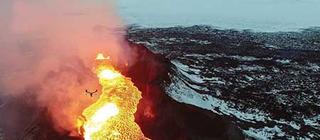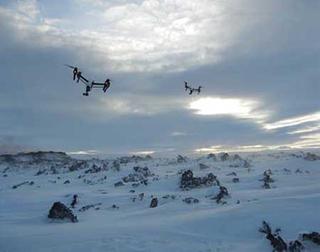Drone Action Heats Up

PHOTO CREDIT: Liz Sintay/ABC News
VATNAJÖ, ICELAND—On Feb. 3, ABC-TV’s “Good Morning America” took its viewers right inside the heart and heat of Iceland’s very active Bardarbunga Volcano, courtesy of two HD-camera/transmitter-equipped DJI Inspire 1 drones flown by DJI remote-control pilots Eric Cheng and Ferdinand Wolf. Flying within 200 feet of the volcano’s 2,100-degree lava flow and streaming live to a satellite uplink back to London (and then via fiber to ABC studios in New York City), the footage these drones captured was awe-inspiring. (The footage can be viewed online at https://thescene.com/watch/abcnews/inside-a-volcano-with-ginger-zee.)
“The footage was beyond surreal,” said GMA and ABC News Chief Meteorologist Ginger Zee, who anchored the live shot four-fifths of a mile from the volcano on a frigid Icelandic glacier, along with a GMA field crew and DJI’s drone pilots. This was as close any human could safely get to the eruption’s heat and toxic gases. “The drones flew us and our viewers along the volcano’s lava flow right into its mouth, at a resolution and detail level that made us all feel as if we were right there!”
“We got so close to the lava, that we melted some of the drones’ exterior plastic parts,” added DJI’s Eric Cheng. “We only discovered this when the drones returned to base.”
GMA VERSUS THE VOLCANO
GMA’s drone footage is an astounding broadcast achievement in its own right. What makes this live hit even more impressive is how quickly the shoot was thrown together on a minimal budget, insanely tight schedule and hostile weather/flying conditions that changed from minute to minute. The Duke of Wellington’s candid description of his just-barely-made it defeat of Napoleon at the Battle of Waterloo characterizes what GMA pulled off in Iceland: “It was... the nearest run thing you ever saw in your life.”
In the case of GMA and the volcano, the idea for doing a drone shoot inside a volcano came from GMA Senior Producer Morgan Zalkin. “For sweeps week in February, we were planning a five-day event called ‘Game of Drones,’ a play upon the hit TV series ‘Game of Thrones,’” said Maria Stefanopoulos, GMA’s production manager (logistics). “We planned to start small, with drones delivering coffee and messages to our anchor desk and around our studio. Shooting inside a volcano seemed a great way to up the ante and maximize our audience.”
Get the TV Tech Newsletter
The professional video industry's #1 source for news, trends and product and tech information. Sign up below.

Geophysicist Bjorn Oddsson is interviewed by ABC News Chief Meteorologist Ginger Zee during the live broadcast. Drone operator Eric Cheng is in the foreground and the handheld camera is operated by Magnus Magnusson of Saga Films, Reykjavik. PHOTO CREDIT: Liz Sintay/ABC News Zalkin pitched her idea in late January. GMA’s producers agreed, and what followed were two insane weeks of planning to get Zee and production/uplink crew to Iceland for the shoot. Iceland’s Nördurflug Helicopter Tours was contacted by Stefanopoulos to provide fast transport for Zee and her crew on the morning of the shoot; flying one hour from Reykjavik on the island’s west side to the volcano in its center. (The rest of the crew came in on the Sunday before via SUVs; surging across the glacier field like a commando squad in a James Bond movie.)
“We set up a 1.2-meter satellite dish, with the uplink equipment in one of our SUVs,” said Faruna Sanoon, GMA’s engineering manager. “GMA shot onsite using a Sony PMW-500 HD camera, backed up by a Sony PMW-200. This video, plus the feeds from the DJI Inspire 1 drones, were combined back at our SUV and transmitted by satellite back to London, then sent by fiber to New York. We used BGAN satellite comms connections for two-way voice and data communications, because there is no cellular service in this remote area of Iceland.”
CONSTANT CHALLENGES
The weather conditions at the Bardarbunga Volcano change constantly, with clear skies turning to blinding blizzards and high winds at a moment’s notice. Then there’s the volcano itself: the eruptions that began in late August 2014 come and go as they please. (At press time, they had stopped.)
GMA’s Maria Stefanopoulos knew none of this when she started planning the shoot. “Here was this New York girl, asking the people in Iceland for a 10-day forecast at a site where any kind of forecasting is pretty much impossible,” she said. “They just laughed and laughed.”

Two DJI drones fly over the Bardarbunga Volcano lava field. The volcano’s fissure is visible on the left. PHOTO CREDIT: Liz Sintay/ABC News Stefanopoulos learns quickly, which is why she pushed through all of the planning issues. “Getting permits proved to be the easiest thing to do, rather than the hardest,” she said. “Our local fixer Einar Erlendsson really helped connect the dots and point us in the right direction.”
Unfortunately, with the only available window for the live hit coming on Tuesday, Feb. 3, all GMA’s producers could do was pray that the weather and volcano cooperated. Below-zero conditions made life difficult for the GMA crew setting up at the Bardarbunga Volcano. When the test shoot/live link to New York was done on Monday, Feb. 2, the signals from the drones kept cutting in and out. “We got enough to piece together some footage,” Stefanopoulos said. “We figured that if things went south on Tuesday, we could always run it instead.”
To add to the challenge, GMA’s crews discovered that the drones’ 60/fps frame rate wasn’t compatible with their 59.94 fps equipment. “We had to rig up a convertor on site to get them to work together,” Sanoon said. “Luckily, it worked.”
On Monday night, following her day on GMA and World News Tonight, Zee got on a jet and headed to Iceland. “Add in the helicopter ride and our need to get on site fast, and I got just a few hours’ sleep,” Zee said. “By the time I got to the volcano, I was pumped but a bit sleep deprived.”
Incredibly, when ABC New York brought Zee up live via satellite/fiber, everything worked. DJI’s drone pilots managed to deliver continuous, steady footage of the volcano and its lava flow, despite being buffeted by 20–30 knot winds and constant heat updrafts generated by the lava below them. “It all came together!” said Cheng.
Looking back on GMA’s amazing volcano coverage, Ginger Zee declared, “I want to have a drone now for every location shoot I do. The footage we got was nothing short of incredible: The drones made our live shoot extraordinary!”
James Careless is an award-winning journalist who has written for TV Technology since the 1990s. He has covered HDTV from the days of the six competing HDTV formats that led to the 1993 Grand Alliance, and onwards through ATSC 3.0 and OTT. He also writes for Radio World, along with other publications in aerospace, defense, public safety, streaming media, plus the amusement park industry for something different.

